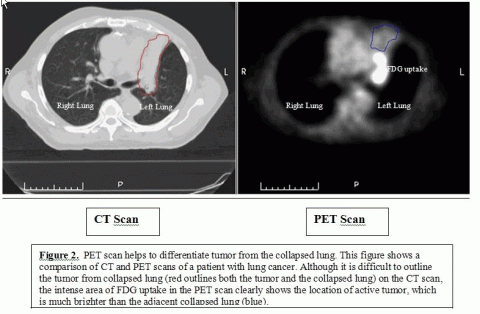Translational Research
Often the research in both our clinical research and basic science research areas overlap into one and are best categorized as translational research. The below listed areas are just a few innovative treatment approaches of our radiation oncology faculty scientists.

Molecular Imaging in Radiation Therapy
The success of radiation therapy for the treatment of cancer is critically dependent on how accurately and precisely we are able to detect the location and amount of cancer in your body. With current imaging technologies used in radiation therapy planning such as CT scan, and PET scan, we are only able to detect cancer when it is at least 1/3 of an inch in length, or approximately when 1 million cancer cells have formed.
The success of radiation therapy in its ability to eradicate your tumor is inversely correlated with the number of cancer cells that are needed to be killed. Therefore, if we are able to detect cancer at a much earlier stage than described above, we will vastly improve our chance of achieving tumor control. Currently, we are investigating novel imaging approaches that can image a single molecule on an individual tumor cell in animals. Novel biological imaging tools as precise as this are highly likely to be translated into more sensitive imaging modalities in the imaging of human cancers.

Combining Targeted Therapy with Radiation Therapy
Another goal of the translational research program at UCLA is finding novel and sensible ways of combining targeted agents (i.e. bevacizumab and cetuximab) with radiation therapy. These targeted agents are drugs that specifically attack tumor cells, or attack tumor-associated blood vessel cells that carry specific molecules on their cell surface. By being more specific, without having uniform toxicity profiles for both normal and tumor cells, these targeted agents offer the possibility of better efficacy with much less side effects. These targeted therapies are an improvement over traditional chemotherapeutic regimens.
Furthermore, targeted agents used in conjunction with radiation therapy, may significantly enhance the effectiveness of radiation therapy without the addition of significant toxicities. Currently however, it is not clear as to how best to combine targeted therapies with radiation therapy. The Department of Radiation Oncology at UCLA is invested in using preclinical models to optimize the delivery of approved as well as novel targeted agents with radiation therapy. With better characterization of these optimal schedules, we will translate them into the clinical setting in early phase clinical trials. Our aim is to improve the efficacy of radiation therapy and ultimately improve our cure rates in cancer.
Finding Novel Targeted Therapies
As mentioned above, targeted therapies offer significant advantages above traditional toxic chemotherapies. At UCLA, we are interested in discovering novel targeted therapies using a rationale drug discovery approach. For example, in the laboratory, we have developed a non-invasive way to monitor when a tumor specific molecule is activated (turned on) which can ultimately lead to cancer cell growth and spread. In these artificially engineered cancer cells, we can test thousands of small molecule drug compounds in a systematic as well as a high through-put manner in order to find these specific drugs. The discovered drugs will be able to turn off the targeted cancer promoting pathways. By turning off a known important cancer promoting pathway, these drugs have a high potential to halt the growth of cancer cells as well as disrupt the function of cancer supporting cells, such as tumor-associated blood vessel cells. This non-invasive monitoring system can be applied to unlimited number tumor specific molecules, providing a powerful and rationale drug screening platform.
Finding Novel Targeted Therapy: Using a novel approach, UCLA Radiation Oncologists and researchers use the IVIS Imaging System to find new targeted drugs that can turn off the receptors involved new blood vessel formation used by tumors. This approach is applied to screening new drugs in tumor cells in tissue culture as well as in animal models.